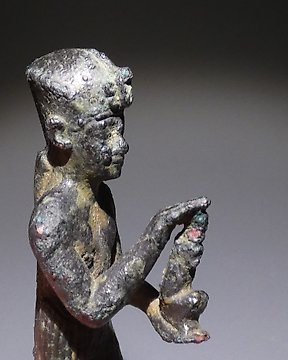
古埃及 黄铜色 法老交付了一位女神玛特。 11 cm H. 晚期,公元前 664 - 332 年 - 9 cm
编号 79805895

编号 79805895

God Osiris.
Ancient Egypt, Late Period, 664 - 332 BC.
Bronze and gold leaf.
Height 24 centimetres. 28 centimetres with the stand.
PROVENANCE: Private collection, D. Javier Villacieros Machimbarrena, ambassador of Spain in Egypt from 1972 to 1976, Madrid, Spain.
CONDITION: Good condition. The feets are missing. Without restorations.
DESCRIPTION:
Originally, the figure of Osiris was linked to the fecundity of the Egyptian soil, the renewal of vegetation and the world of shepherds, as evidenced by the heka sceptre (which reproduces the shepherds’ crook). He embodied the fertile land and the arable fields, and therefore became the guardian of the order of the universe and the cycles of nature. But the most famous myth concerning him is the one in connection with his death, known through many versions: the son of Geb (the earth) and Nut (the sky) and the husband of Isis, the god primarily was a pharaoh. With Isis, they were a pair of royal benefactors who taught mankind farming and fishing (Osiris), weaving and medicine (Isis). Jealous of the sovereign, his brother Seth assassinated him, cut up his body and disposed of the pieces in the Nile. However, Isis, his wife and faithful widow, found and reassembled the body of her husband and, with the help of her sister, Nephtys, and of Anubis, she embalmed the corpse. After breathing life into him for a short instant, Isis was impregnated by Osiris: this union resulted in the birth of Horus, who, following in the footsteps of his father, became Pharaoh. And so, after having survived the ordeal of death, Osiris triumphed thanks to the magic of his wife and became the ruler of the underworld. He represented the seeds of life and, at the same time, was the protector of the deceased, to whom he would promise life after death.
These two closely related characteristics linking the god of fecundity and the funerary divinity were certainly the basis for the success Osiris enjoyed in the Egyptian world: from the New Kingdom on, and especially during the entire 1st Millennium BC, statuettes of Osiris were among the most important funerary offerings.
The technique of lost wax casting is a sculptural procedure using a mould made from a prototype of the piece to be worked, and this prototype is usually made from beeswax. This is covered with a thick layer of soft material, usually clay, which then solidifies. Once this has hardened it is put in a kiln where the wax inside melts and leaks out through expressly made holes in the clay. In its place molten metal is injected and this takes on the exact form of the mould. To release the final piece the mould must be removed.
Notes:
- The piece includes authenticity certificate.
- The piece includes Spanish Export License (Passport for European Union). NOT TAXES.
- According to Spanish legislation, items sent outside the European Union are subject to export taxes and will be added to the invoice, at the buyer's expense. These export fees are fixed on the final auction price and the tax rate is not applied directly on the total value of the item to be exported, but rather the different percentages by sections are applied to it:
- Up to 6,000 euros: 5%.
- From 6.001 to 60.000 euros: 10%.
This export permit application process can take between 1-2 months maximum.
- The seller guarantees that he acquired this piece according to all national and international laws related to the ownership of cultural property. Provenance statement seen by Catawiki.